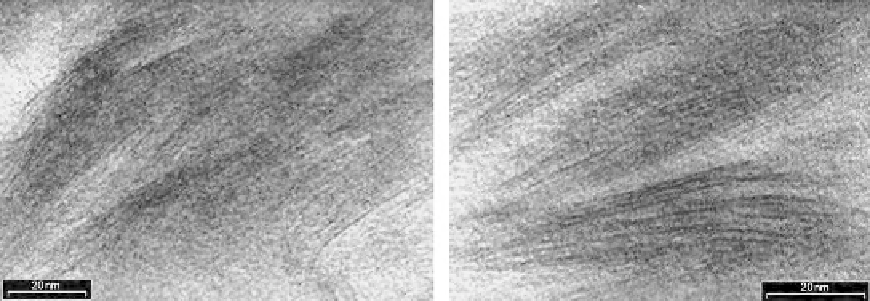Biomedical Engineering Reference
In-Depth Information
Another filler type is the titanium dioxide nanofillers (TiO
2
), which was added in small amount
to improve the mechanical properties of the adhesive. By mixing the TiO
2
nanoparticles with
acrylic acid, agglomerated fillers were produced. By adding these agglomerated fillers at a concen-
tration of 0.08% mass fraction, the DC was significantly higher with approximately 5% more than
the unfilled one. The flexure modulus was increased by about 48% when 0.06% mass fraction of
nanofillers was added and the hardness was almost double with this amount of mass fraction. The
shear bond strength was significantly improved (about 30% higher compared to the unfilled one)
when the filler mass fraction was 0.1%. Nevertheless, the durability and stability of such filler type
in dental adhesive should be given much attention in the future research
[28]
.
Recently, poly-methyl methacrylate (PMMA)-grafted nanoclay fillers were evaluated
(
Figure 7.13
). The authors dispersed the nanoclay fillers as a part of the chemical composition of
an experimental adhesive. The 1 wt% PMMA-grafted nanoclay dispersion showed dispersion stabil-
ity over 12 h and the DC was not affected with different percentage of the PMMA-grafted nano-
clay. On the other hand, the microshear bond strength was significantly improved with adding
PMMA-grafted nanoclay as filler
[29]
.
With the improvement of the nanotechnology in the dental field, newly developed fillers are being
incorporated within the adhesives. Solhi et al.
[30]
synthesized PAA nanoclay as reinforced fillers
within an experimental adhesive (
Figures 7.14 and 7.15
). Adding of PAA-grafted nanoclay fillers did
not affect the DC of the experimental adhesive at any percent filler loading (0.2
5 wt%). The micro-
shear bond strength was significantly improved by adding only 0.2 wt% of the PAA-grafted fillers
(
Figure 7.16
). It could be suggested that the incorporation of PAA-grafted nanoclay fillers could
enhance chemical bonding through ion exchange between the carboxylic group in the PAA and the
calcium ion in dentin. However, this suggestion needs further research investigation.
As the filler type could also affect adhesives' properties, certain fillers were added to enhance
specific properties of the adhesive. Flame-made tantalum butoxide/silicon oxide (Ta
2
O
5
/SiO
2
)
nanofillers were added to increase the radiopacity of the adhesive (
Figure 7.17
). During routine
radiograph examination,
the difference between the recognition of the adhesive layer and the
FIGURE 7.13
TEM micrographs of the adhesive containing 1 wt% PMMA-grafted nanoclay showing partially delaminated
clay platelets.



